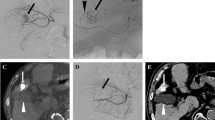Summary
Purpose: To document our experience with spiral hydro-CT of the pancreas based on a combination of pharmacologic intestinal paralysis and water distension of the stomach and duodenum with specific reference to tumor detection rate, differentiation of malignant versus benign tumors and assessment of tumor resectability in a prospective study on 211 consecutive patients.
Material and methods: Between May 1994 und September 1997, 211 patients with suspect of pancreatic neoplasm from clinical, laboratory or other imaging data were examined. Our Hydro-CT techniques were based on intravenous injection of 40 mg N-butylscopolaminiumbromid (Buscopan) for intestinal paralysis, gastric and duodenal wall distension by oral administration of an average of 1.5 l warm tap water, 30 ° RAO patient's positioning, individualized contrast injection technique using portal vein enhancement as reference and thin slice spiral CT (3 mm slice thickness, 6 mm table feed and 3 mm secondary reconstruction). Examined parameters were: (1) tumor detection rate, (2) differentiation of malignant versus benign disease, (3) differential diagnosis and (4) accuracy of assessment of resectability by identification of infiltration into adjacent organs and vessel structures relevant for resectability such as splenic, superior mesenteric, portal vein and celiac trunk, superior mesenteric, splenic and hepatic arteries. As gold standard for positive tumor detection and description surgery (of potentially resectable tumors) and microscopic diagnosis (of clearly unresectable tumors) were used and for negative tumor detection an event-free survival of six months, respectively.
Results: 96 % of the examinations were well tolerated. In only 4 % was on-site administration of a gastric tube required because of vomiting. In 2 % of the patients a slight allergic reaction to the contrast medium was seen. The prevalence of a pancreatic neoplasm was 37,8 %. In tumor detection Hydro-CT reached an overall accuracy of 94,8 % with a sensitivity of 93,7 % and a specificity of 95,2 %. 52 patients underwent surgical exploration 34 of whom with tumorfree resection margins (R0 resection) corresponding to a resection of 42,5 %. In those assessment of resectability reached an overall accuracy of 94,6 % with a sensitivity of 91,2 % and specificity of 95,6 %.
Conclusion: The new technique of Hydro-CT based on thin slice and spiral methodology including pharmacologic intestinal paralysis and water distension results in a high tumor detection rate and reliable assessment of resectability.
Zusammenfassung
Ziel: Darstellung unserer Ergebnisse der Hydro-CT-Technik zur Diagnostik des Pankreaskarzinoms, basierend auf einer mehrjährigen Anwendung an einem Krankengut von nunmehr 211 Patienten.
Material und Methode: Zwischen Mai 1994 und September 1997 wurden in einer prospektiven Studie 211 konsekutive Patienten mit klinischem, laborchemischem oder durch vorherige Bildgebung begründetem Verdacht auf Pankreastumor mittels Hydro-CT-Technik untersucht (Darmparalyse, Magen- und Duodenaldistension, individualisierte Boluskinetik, Dünnschichtspiral-CT mit 3 mm Schichtdicke, 6 mm Tischvorschub und 3 mm Rekonstruktionsintervall). Untersuchungsschwerpunkte waren: 1. Tumordetektion, 2. Differenzierung maligner oder benigner Veränderungen, 3. Differentialdiagnostik der Tumoren, 4. Beurteilung der Resektabilität. Bei positivem Tumornachweis wurde als Goldstandard die intraoperative (potentielle resektable Tumoren) und histologische Bewertung (sicher irresektable Tumoren) und bei fehlendem Tumornachweis eine 6monatige tumorfreie Nachsorgeperiode festgelegt.
Ergebnisse: Bei 94 % aller Patienten war die Hydro-CT problemslos durchführbar. Die Prävalenz eines malignen Pankreastumors betrug 37,9 %. Dabei erreichte die Hydro-CT eine Gesamtgenauigkeit in der Tumordetektion von 94,8 % bei einer Sensitivität von 93,7 % und einer Spezifität von 95,2 %. 52 Patienten wurden operiert, davon 34 kurativ (RO-Resektion) entsprechend einer Resektionsrate von 42,5 %. Die Gesamtgenauigkeit der Resektabilitätsbeurteilung erreichte 94,6 % bei einer Sensitivität von 91,2 % und einer Spezifität von 95,6 %.
Schlußfolgerungen: Die Hydro-CT des Pankreas in Dünnschicht- und Spiraltechnik mit individueller Anpassung der Kontrastmittelboluskinetik ermöglicht eine hohe Tumordetektionsrate und eine hohe Sicherheit in der Resektabilitätsbeurteilung von Pankreastumoren.
Similar content being viewed by others
Author information
Authors and Affiliations
Rights and permissions
About this article
Cite this article
Richter, G., Wunsch, C., Schneider, B. et al. Hydro-CT in the detection and staging of pancreatic carcinoma. Radiologe 38, 279–286 (1998). https://doi.org/10.1007/s001170050355
Issue Date:
DOI: https://doi.org/10.1007/s001170050355




